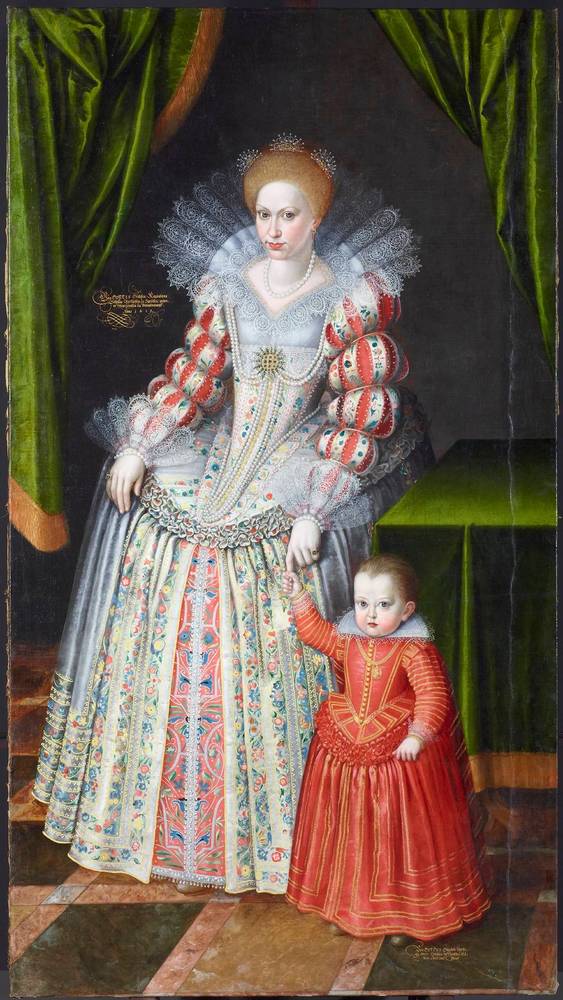
Magdalena Sibylla of Prussia (1586-1659). Daughter of Albrecht Friedrich, Duke of Prussia and his consort, Marie Eleonore of Cleves. Married Johan Georg I, Elector of Saxony in 1607, becoming his second wife and Electress consort. Had ten children, including daughter Magdalena Sibylla. Widowed in 1656.
Figure 1.1. Artist unknown, Magdalena Sibylla, Electress of Saxony (1586-1659), with her son, Christian of Saxe-Merseberg, 1617, oil on canvas, 220 x 120 cm, Old Masters Picture Gallery, Dresden, Inv.-Nr. 99/45, source: SKD.
The Dresden Armoury possesses three ensembles from the wardrobe of Electress Magdalena Sibylla of Saxony, which is remarkable, considering that it is extremely difficult to find centuries-old clothing that once belonged to European royalty. Still more rare are items that can match her surving garments in terms of condition, completeness and magnificence. Usually, queens and the consorts of rulers gifted their highly expensive dresses to ladies-in-waiting and to churches for the vestments of priests or an altar cloth. The Electors of Saxony instead chose to preserve these precious garments.
Early 17th century
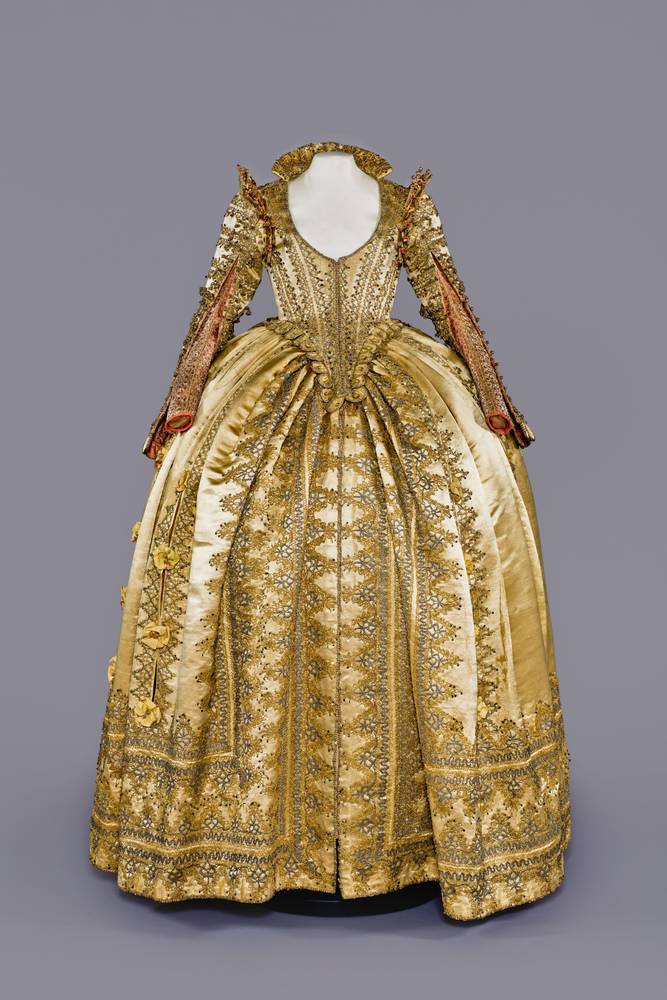
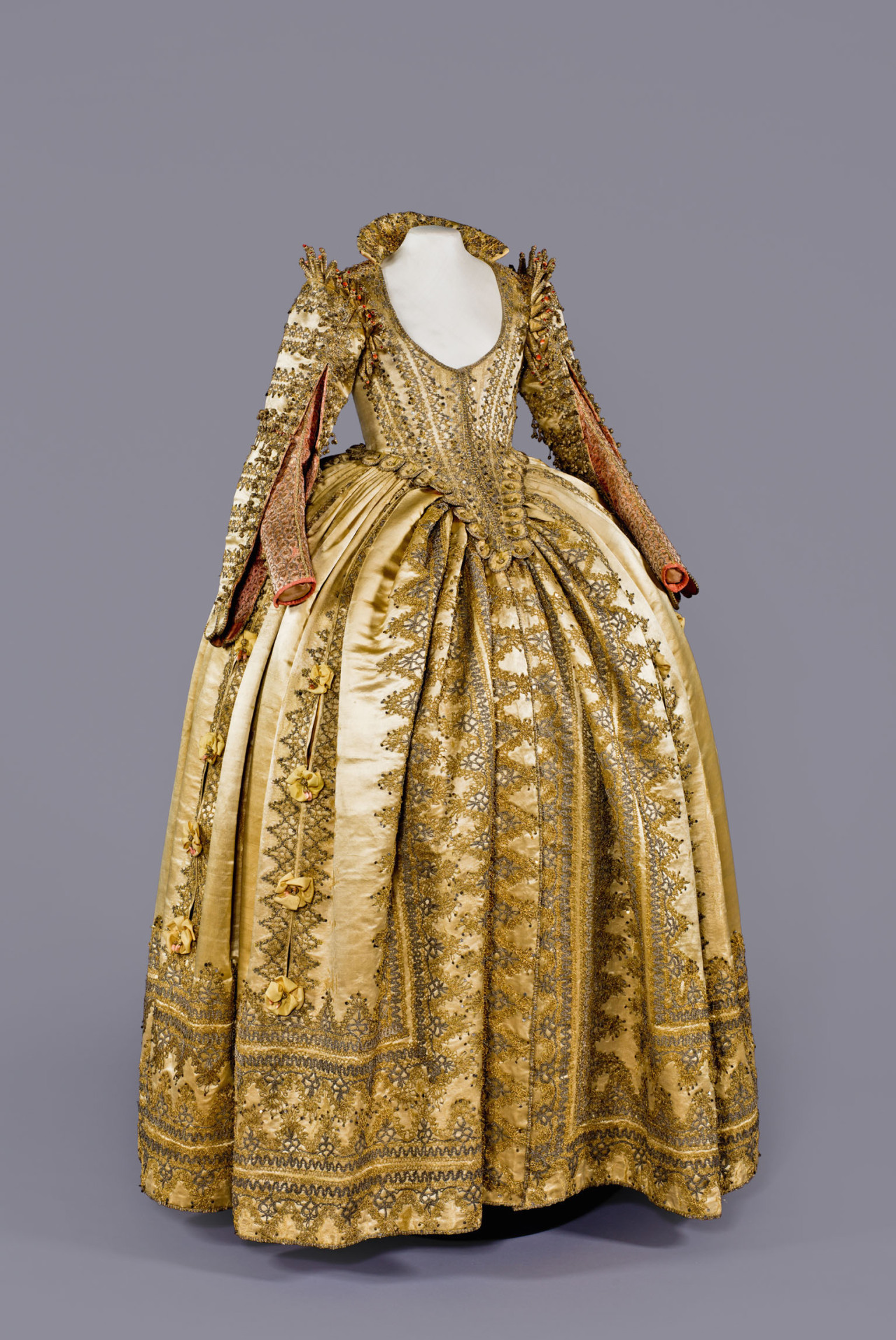
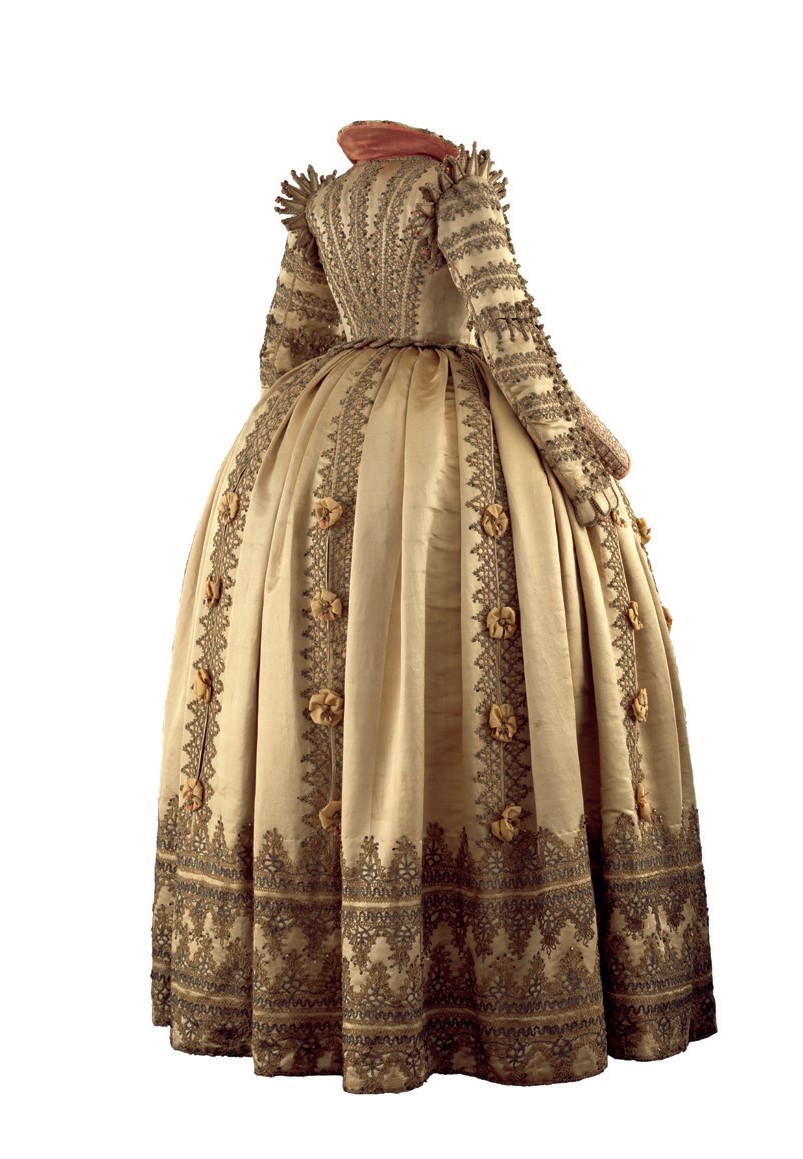
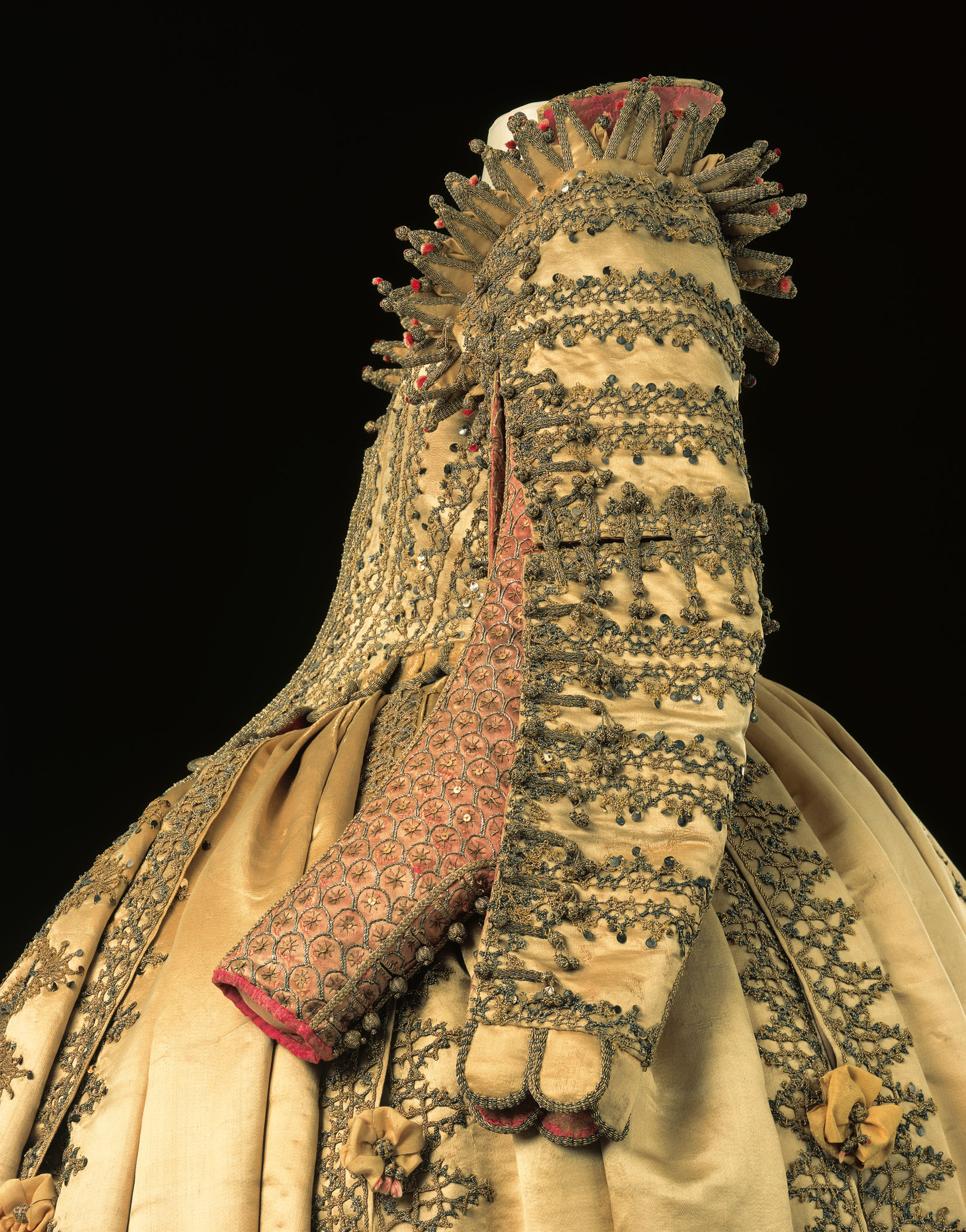
The Electress of Saxony’s ceremonial dress from the 1610s is made of golden-yellow silk satin embellished with gold and silver trimmings and gold embroidery. It has a low-cut bodice that closes in the front by means of concealed hooks and eyes and ends in a long, narrow point, which juts out over a bell-shaped overskirt. An underskirt (now missing) would have been visible through the gap between the two edges of the overskirt in the front, as well as the long slits in the overskirt itself, which are held together by yellow taffeta rosettes. As figure 1.2 shows, the bodice also has split, curved, Spanish-style sleeves that could have been worn hanging with the buttons undone to reveal tight, richly embroidered salmon-pink undersleeves, the cuffs of which close with buttons. The prominent shoulder wings are composed of spikes, each of which is topped with a bright-red silk pompom. A lace collar held up by wire supports and lace ruffs at the wrists would have completed the outfit.1
Electress Magdalena Sibylla’s ensemble does not greatly differ from clothing worn by Marie de’ Medici (1575-1642), Queen of France and other royal contemporaries.2 Indeed, the dress has many features in common with the outfits worn by Marie de’ Medici and Anne of Denmark (1574-1619), consort of King James I of England (1566-1625), in the images in figure 1.3, particularly as far as silhouette and the cut of the bodice and sleeves are concerned.
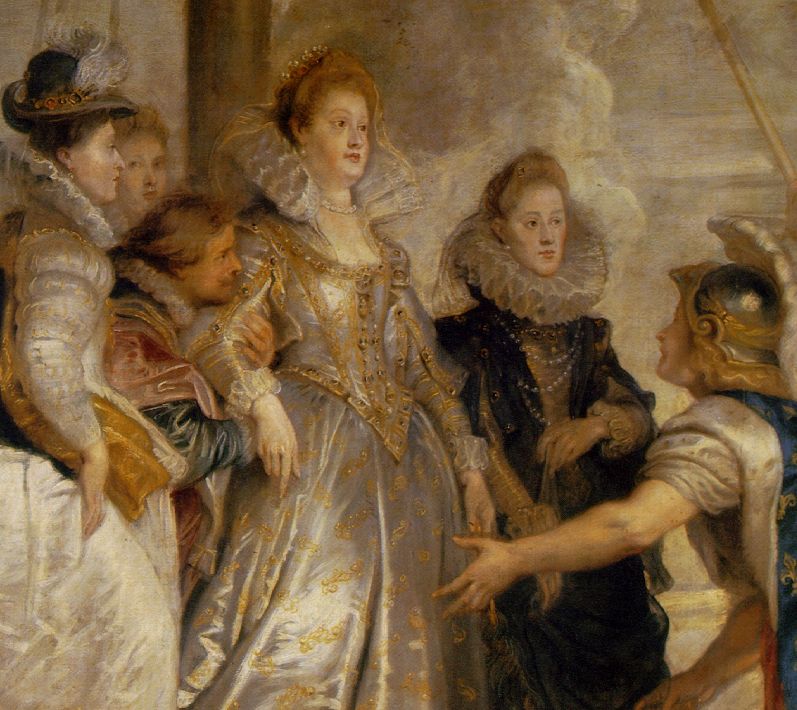
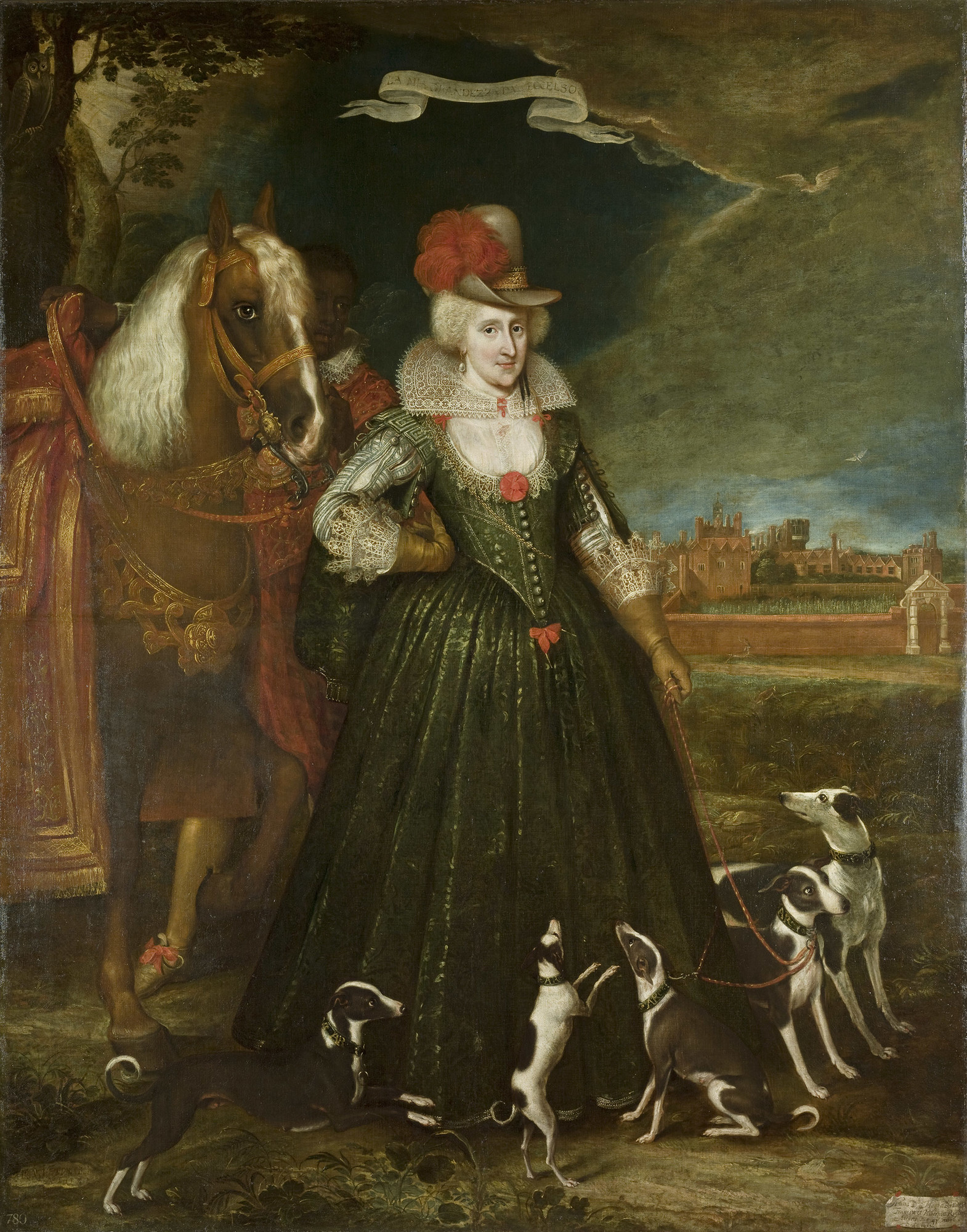
Mid-17th century
During the 1640s and 1650s, stylish dress consisted of a fitted, low-necked bodice that was off-the-shoulder, with a lace collar to cover the décolletage. The bodice was boned, eliminating the need for stays or a corset; it was long-waisted, ending in a substantial point in the front. As a result, the skirt appeared flat in the front, but the many cartridge pleats encircling the rest of the waist created volume at the sides and the back. The sleeves were short and full and finished with lace cuffs. A visibly older Electress Magdalena Sibylla wears an outfit that reflects these trends in figure 1.4. Her pearl accessories and hairstyle—flat hair on the top, with ringlets on either side of the head—were also very much in vogue at the time.3
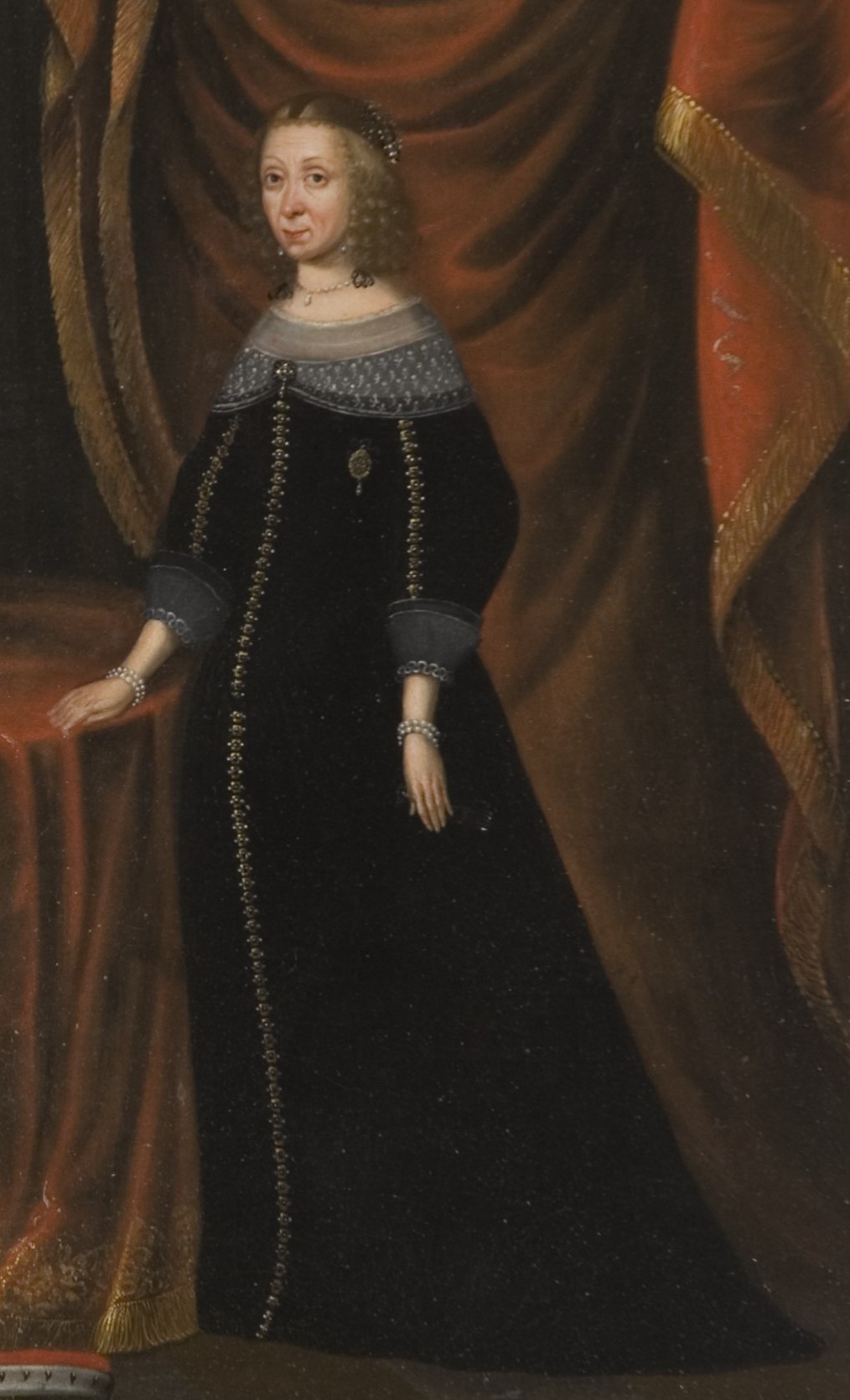
The Dresden Armoury has two gowns from around 1650 that belonged to the Electress, and while they are in keeping with the fashions of the time, they are also very festive-looking, compared to the sober black dress in her portrait. According to the museum, one of them, a dress in amaranth-red silk and gold brocade, embellished with gold lace and passementerie (see figure 1.5), might have been reserved for an exceptional occasion, such as the double wedding of the Electress of Saxony’s sons Moritz (1619-81) and Christian (1615-91) in 1650.4
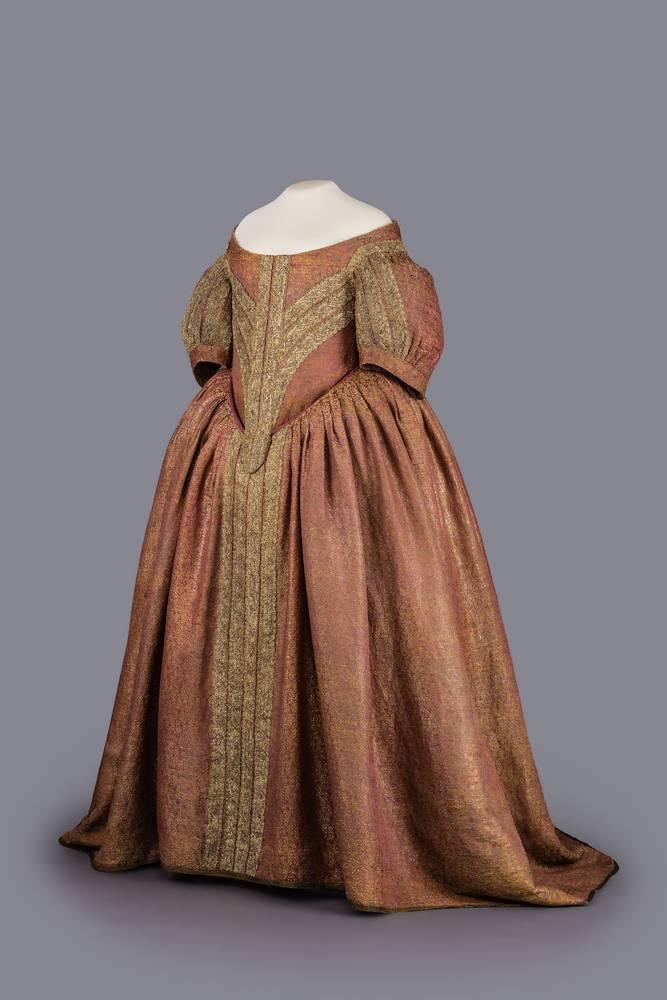
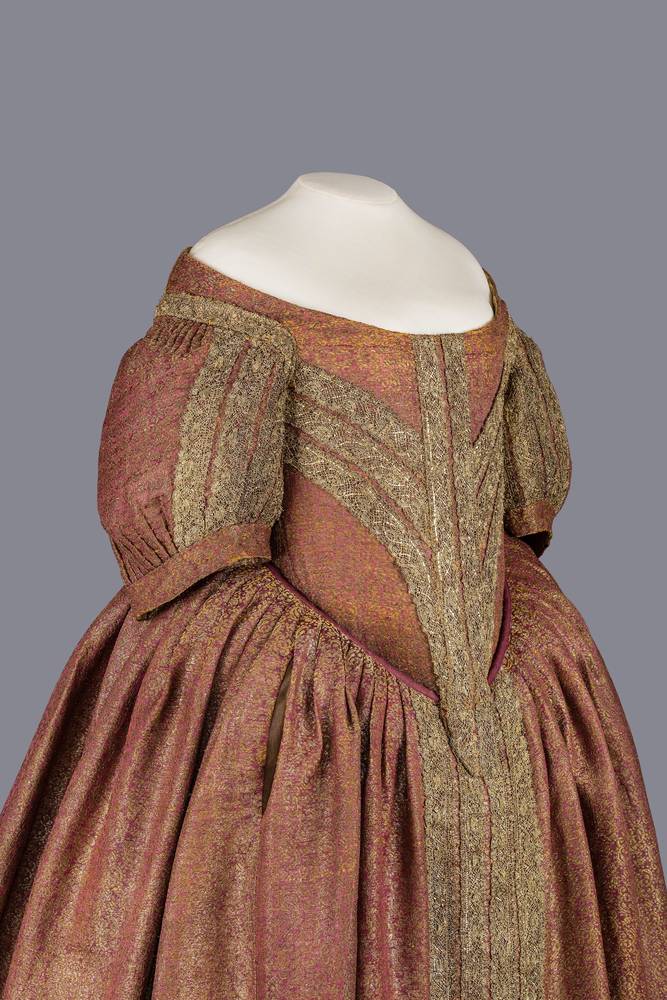
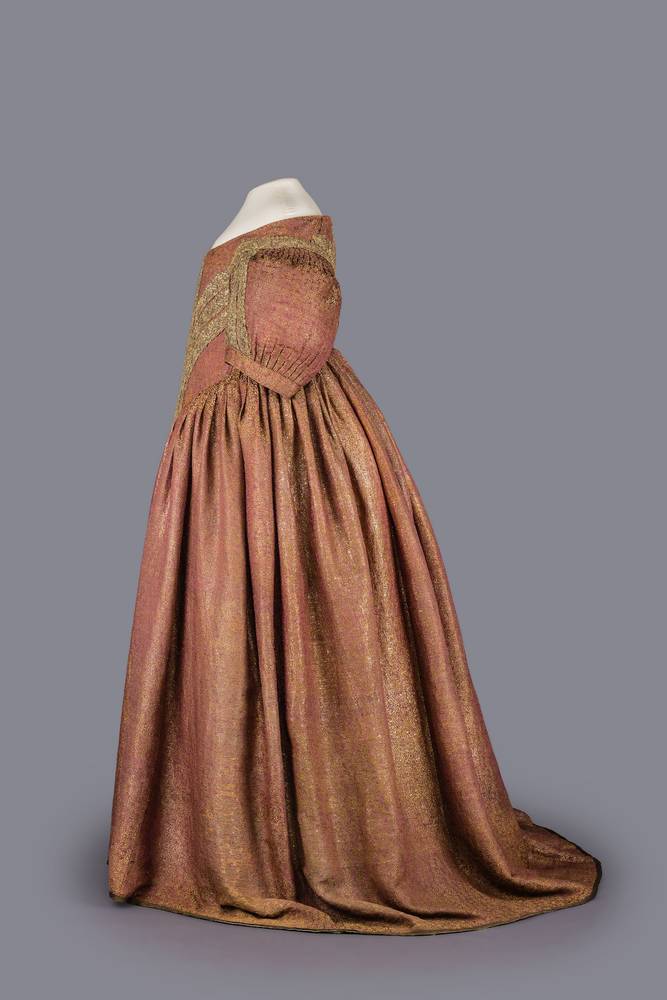


The Electress of Saxony could also have worn such a dress with a chemise to cover the very low, rounded neckline, rather than a deep lace collar, like the subject of a 1649 portrait by Bartholomeus van der Helst (1613-70) seen in figure 1.6. The sitter’s chemise is of a thin, pleated material trimmed with gold lace that puffs out so that the neckline underneath is completely concealed.5 Interestingly, her bright reddish-orange gown, the edges of its seams marked with silver metallic lace,6 greatly resembles the purple-red ensemble at the Dresden Armoury, indicating that Electress Magdalena Sibylla was certainly not behind on fashion trends.

The second ensemble from circa 1650 is of lemon-coloured silk satin, decorated with silver passementerie and strips of silver lace where the seams close (figure 1.7). Its rich silver embroidery, which takes the form of flowers and bows, incorporates 78,900 sequins.7 When viewed from the side, the bodice, with its elongated point that projects stiffly over the skirt, looks very much like the beak of a bird.8

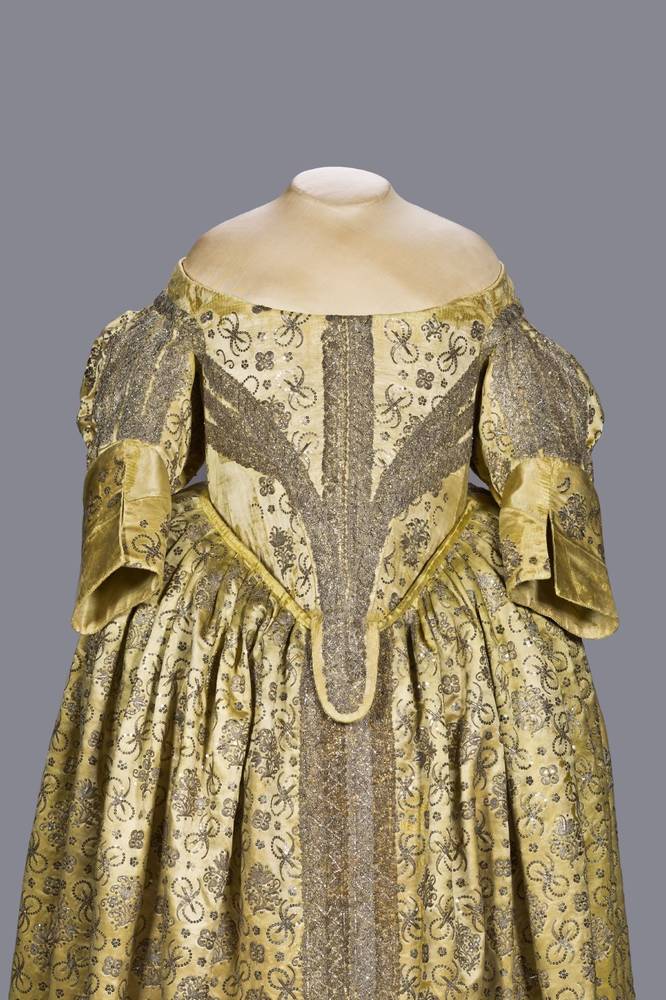

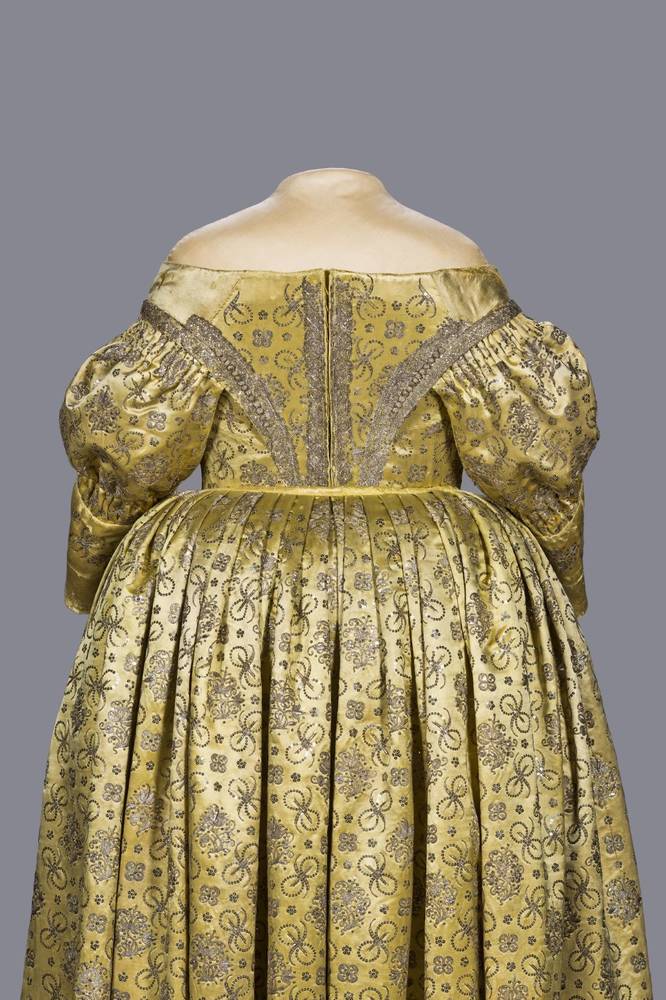
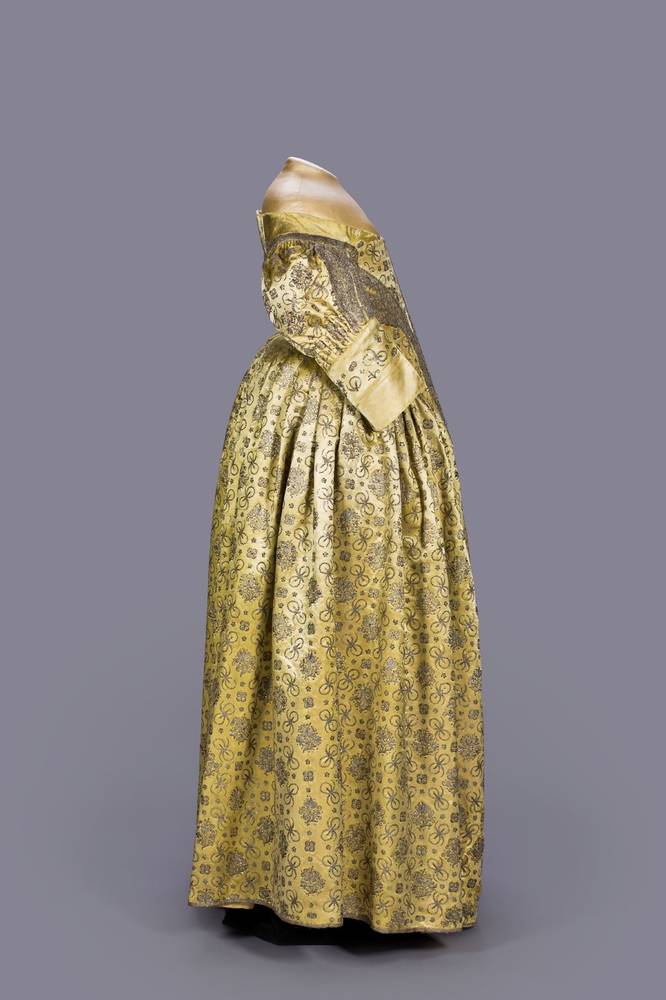

Notes
1. “Prunkkleid der Kurfürstin Magdalena Sibylla von Sachsen,” Staatliche Kunstsammlungen Dresden, accessed June 30, 2023, https://skd-online-collection.skd.museum/Details/Index/2426467.
2. Ibid.
3. Justine De Young, “1650-1659,” Fashion History Timeline, last updated August 18, 2020, https://fashionhistory.fitnyc.edu/1650-1659/.
4. Jutta Charlotte von Bloh, “Prunkkleid der Kurfürstin Magdalena Sibylla von Sachsen bestehend aus mieder und rock,” Staatliche Kunstsammlungen Dresden, accessed June 30, 2023, https://skd-online-collection.skd.museum/Details/Index/3065739.
5. Justine De Young, “1640-1649,” Fashion History Timeline, last updated August 18, 2020, https://fashionhistory.fitnyc.edu/1640-1649/.
6. Ibid.
7. Jutta Charlotte von Bloh, “Prunkkleid der Kurfürstin Magdalena Sibylla von Sachsen bestehend aus mieder und rock,” Staatliche Kunstsammlungen Dresden, accessed June 30, 2023, https://skd-online-collection.skd.museum/Details/Index/3065734.
8. Ibid. The German word schneppe in schneppenteile means “beak,” and thus conjures up for the reader the image of a stiff bodice that has been reinforced with whalebone.
Bibliography
Bloh, Jutta Charlotte von. “Prunkkleid der Kurfürstin Magdalena Sibylla bestehend aus mieder und rock.” Staatliche Kunstsammlungen Dresden, accessed June 30, 2023. https://skd-online-collection.skd.museum/Details/Index/3065734.
———. “Prunkkleid der Kurfürstin Magdalena Sibylla von Sachsen bestehend aus mieder und rock.” Staatliche Kunstsammlungen Dresden, accessed June 30, 2023. https://skd-online-collection.skd.museum/Details/Index/3065739.
De Young, Justine. “1640-1649.” Fashion History Timeline, last updated August 18, 2020. https://fashionhistory.fitnyc.edu/1640-1649/.
———. “1650-1659.” Fashion History Timeline, last updated August 18, 2020. https://fashionhistory.fitnyc.edu/1650-1659/.
Staatliche Kunstsammlungen Dresden. “Prunkkleid der Kurfürstin Magdalena Sibylla von Sachsen.” Accessed June 30, 2023. https://skd-online-collection.skd.museum/Details/Index/2426467.